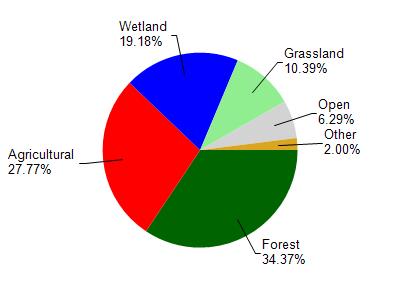Waushara
No
No
No
Fish and Aquatic Life
Overview
Johns Lake, in the Pine and Willow Rivers Watershed, is a 70.82 acre lake that falls in Waushara County. This lake is managed for fishing and swimming and is currently not considered impaired.
Date 2011
Author Aquatic Biologist
Historical Description
Source: 1970, Surface Water Resources of Waushara County
John's Lake T-19-N, R-11-E, Sections 32, 33
Surface Acres = 66.7; S.D.F. = 1.40; Maximum Depth = 41 feet
A drained lake that is characterized by a somewhat
rectangular basin. The lake derives its primary water source
from seepage and springs. The littoral, bottom zone is quite
extensive along the southern shoreline. The primary bottom
materials in this zone include sand and marl with some gravel.
The lake develops a midsummer thermocline at a- depth of 22 feet.
The outlet of the lake forms the headwaters of Bruce (Thorstad)
Creek. The immediate watershed area of the lake encompasses less
than one square mile of primarily wooded uplands. Depth and
overall water quality permits this lake to be managed as a two
story fishery, with both warm water and cold water fish species.
The primary fish species occurring in the lake include northern
pike, largemouth bass, bluegills, rock bass and brown trout.
Habitat for natural reproduction of largemouth bass and panfish
present in the lake is rated as good. Spawning habitat for
northern pike appears to be poor, although young northern pike
occasionally have shown up in fish surveys, indicating that there
is some natural reproduction of this species. The water clarity
of the lake (secchi readings 10 to 15 feet) makes fishing for
the site feeding species difficult. Log crib shelters have been
placed around the lake to provide additional cover. Recreational
use of the lake is primarily for fishing and swimming, with some
boating activity. The water quality and aesthetic values
attached to this lake have encouraged much cottage development.
There are 51 cottages and 5 resorts located along the shoreline.
A public access with limited parking and a boat launching site
are located on the southeast side of the lake.
Date 1970
Author Surface Water Inventory Of Wisconsin
General Condition
Johns Lake (WBIC 245800) was assessed during the 2018 listing cycle; total phosphorus sample data were clearly below 2018 WisCALM listing thresholds for the Recreation use and Fish and Aquatic Life use. This water was also assessed for chlorides and sample data were clearly below the 2018 WisCALM chronic and acute listing criteria for the Fish and Aquatic Life use. For the Fish Consumption use new fish tissue analysis showed no need for specific fish consumption advisories for this lake. This water was meeting these designated uses and was not considered impaired.
Date 2017
Author Ashley Beranek
Condition
Wisconsin has over 84,000 miles of streams, 15,000 lakes and milllions of acres of wetlands. Assessing the condition of this vast amount of water is challenging. The state's water monitoring program uses a media-based, cross-program approach to analyze water condition. An updated monitoring strategy (2015-2020) is now available. Compliance with Clean Water Act fishable, swimmable standards are located in the Executive Summary of Water Condition in 2018. See also the 'monitoring and projects' tab.
Reports
Recommendations
Land Acquisition
The John's Lake Lake Management District will acquire approximately 9.2 acres of land, including 550 feet of shoreline, situated on the western shore of John's Lake in Waushara County, for lake protection purposes.
Management Goals
Wisconsin's Water Quality Standards provide qualitative and quantitative goals for waters that are protective of Fishable, Swimmable conditions [Learn more]. Waters that do not meet water quality standards are considered impaired and restoration actions are planned and carried out until the water is once again fishable and swimmable
Management goals can include creation or implementation of a Total Maximum Daily Load analysis, a Nine Key Element Plan, or other restoration work, education and outreach and more. If specific recommendations exist for this water, they will be displayed below online.
Monitoring
Monitoring the condition of a river, stream, or lake includes gathering physical, chemical, biological, and habitat data. Comprehensive studies often gather all these parameters in great detail, while lighter assessment events will involve sampling physical, chemical and biological data such as macroinvertebrates. Aquatic macroinvertebrates and fish communities integrate watershed or catchment condition, providing great insight into overall ecosystem health. Chemical and habitat parameters tell researchers more about human induced problems including contaminated runoff, point source dischargers, or habitat issues that foster or limit the potential of aquatic communities to thrive in a given area. Wisconsin's Water Monitoring Strategy was recenty updated.
Grants and Management Projects
Monitoring Projects
| WBIC | Official Waterbody Name | Station ID | Station Name | Earliest Fieldwork Date | Latest Fieldwork Date | View Station | View Data |
|---|
| 245800 | Johns Lake | 10007452 | Johns Lake | 6/1/1998 | 6/23/2025 | Map | Data |
| 245800 | Johns Lake | 10019330 | Johns Lake -- Access | 7/28/1993 | 9/26/2018 | Map | Data |
| 245800 | Johns Lake | 703012 | John's Lake - Deep Hole | 3/2/1976 | 10/3/2025 | Map | Data |
|

Watershed Characteristics
Johns Lake is located in the Pine and Willow Rivers watershed which is 302.08 mi². Land use in the watershed is primarily forest (34.40%), agricultural (27.80%) and a mix of wetland (19.20%) and other uses (18.70%). This watershed has 377.48 stream miles, 11,273.01 lake acres and 33,136.61 wetland acres.
Nonpoint Source Characteristics
This watershed is ranked High for runoff impacts on streams, Not Ranked for runoff impacts on lakes and High for runoff impacts on groundwater and therefore has an overall rank of High. This value can be used in ranking the watershed or individual waterbodies for grant funding under state and county programs.However, all waters are affected by diffuse pollutant sources regardless of initial water quality. Applications for specific runoff projects under state or county grant programs may be pursued. For more information, go to surface water program grants.